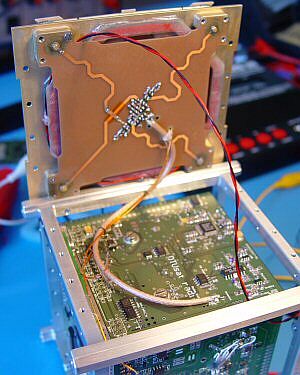
Am 30. Juni 2003, 1415 UTC startete eine zweistufige Rockot-Rakete vom Plesetsk-Raumfahrtzentrum mit neun Satelliten. Neben einem russischen, einem tschechischen und einem kanadischen MicroSat, waren 6 weitere Satelliten einer neuen und preiswerten Bauart, sogenannte CubeSat’s an Bord. Die “Würfel-Satelliten” haben eine Kantenlänge von 10 cm und werden als NanoSat’s klassifiziert. Alle CubeSat’s tragen auch eine Amateurfunk-Nutzlast (Bake).
DTUsat is a picosatellite designed and built by students from the Technical University of Denmark, DTU. The main payload of DTUsat is an electrodynamic tether for dumping the satellite. The tether is deployed using a novel yo-yo system, greatly simplifying construction and deployment. A calibrated test transmitter is flown as secondary payload. The satellite is 3-axis stabilized using magnetorquers, while attitude determination is done by a combination of a 3-axis magnetometer and 5 chip scale dual-axis sun angle sensors designed and built for this satellite. The mass of each sun angle sensor including supporting electronics is only 3 g. All flight electronics is designed using modern 3.3V CMOS integrated circuits, lowering total power consumption to about 400 mW while providing about 10 MIPS for application software.
All electronics in DTUsat is commercial 3.3V small-geometry CMOS to conserve power. We have tested for Total Ionizing Dose, which caused a maximum of 50% power consumption increase over the projected radiation dose. This is well within the power envelope of the system. The first chips are tested to fail at a total ionizing dose of about 7 krad, which translates to about a year given our shielding and orbit. This is sufficient for the mission. We do not yet know the rate of Single Event Upsets, but we have designed a global protection system, that shuts down and reboots the entire satellite by turning off the power supply if a latch-up is detected. Latch-up detection is decentralized to local sensors. Due to lack of power, weight, and time, we have opted for a simple configuration with little redundancy.
DTUsat will share the honour of being the first CubeSats launched with the Danish AAUsat, the Canadian CanX, the American Quakesat, and the Japanese XI-IV and Cute satellites. The CubeSat concept originates from prof. Bob Twiggs of Stanford University.
Orbital Parameter
Name DTUSAT NORAD # 27842 COSPAR Bezeichnung 2003-031-C Inklination (Grad) 98.724 RAAN 198.988 Excentrizität 0.0009169 ARGP 319.156 Umläufe pro Tag 14.20751519 Periode 1h 41m 21s (101.35 Min) Semi-major axis 7201 km Perigäum x Apogäum 816 x 829 km Bstar (drag Faktor) 0.000040627 1/ER Mean Anomaly 40.892
Downlink
437,475 MHz FM AFSK 2k4, 400mW
437,475 MHz CW, 13 wpm
Die Bake sendet aller 2 Minuten einen kurzen Burst.
Jeder 5. Burst (alle 10 Minutes) wird ein CW-Signal “OZ2DTU DTUSAT” gesendet.